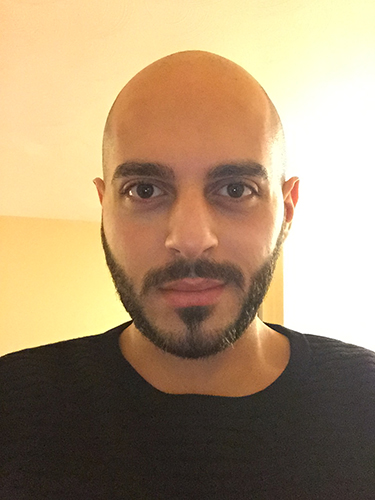When Wes Hatem was considering his options for a co-op in the College of Engineering, he knew he wanted something to feed his burgeoning interest in thermodynamics.
A few after-class conversations with the professor whose course had piqued that interest, Dr. Constance Schall, led him to Dr. Yakov Lapitsky, another professor in the Department of Chemical Engineering. Hatem recalled that Lapitsky generously answered his questions about his research into polyelectrolyte-based materials, including opportunities for Hatem to assist as an undergraduate researcher in Lapitsky’s laboratory.

Hatem
That conversation led to a research co-op, which in turn kicked off an undergraduate research career that’s now netted three co-authorships in peer-reviewed journals. The most recent, in Langmuir, a journal of the American Chemical Society, came in late May.
“I feel so proud to have three co-authorships compiled from my time as an undergrad,” said Hatem, who graduated with a bachelor’s degree in chemical engineering in December 2022 and began working as associate engineer in material development at First Solar. “It was very encouraging and inspiring to have faculty see promise in my work and graciously bring me into their projects. It makes me feel that my work and conclusions are taken seriously and that I am contributing to the movement of advancing science research, even if the projects are small.”
Lapitsky set Hatem up with his initial “small” project during his first co-op, which was supported by Research Experience for Undergraduates funding from the National Science Foundation during the summer semester in 2020.
The College of Engineering requires most undergraduate students to complete three semester-long co-ops, or paid work experiences that are integrated into the curriculum. While most students use the co-op experience to obtain valuable job experience with employers in their field, some, like Hatem, opt for research co-ops that allow them to pursue opportunities in research laboratories on or off campus.
Lapitsky tasked Hatem with exploring how mechanical and magnetic stimuli can accelerate the release of substances from sustained-release materials, like those utilized in a wide variety of applications like drug delivery, food formulation and water treatment. Hatem especially relished the opportunity to pursue his own hypotheses toward this end under the guidance of Lapitsky, recalling that whenever he had time to spare in the lab he would perform experiments with samples destined for the trash.
“In doing some simple side experiments, I found possible alternatives to our original theory that proposed possible solutions to the problem we were exploring,” Hatem said.
He and Lapitsky continued to investigate these alternatives during his second co-op, again supported by the Research Experience for Undergraduates, and their collaboration led to an article in the journal Polymers in 2023. Hatem and Lapitsky are credited as co-authors of the article demonstrating how periodic mechanical stimulation can reactivate the release process when it becomes too slow.
Hatem went on to pursue a parallel interest in biodiesel in a third research co-op the following semester under Dr. Matthew Liberatore, another professor in the Department of Engineering. Under Liberatore, Hatem placed second in a poster competition at the American Institute of Chemical Engineers’ North-Central Regional Conference in 2021. He also contributed to research into the flow and crystallization of saturated fatty acid methyl esters that was published in the Journal of the American Oil Chemists’ Society in 2022.
Then Hatem rejoined Lapitsky for another summer semester of independent study, for which he earned course credit, contributing to a project aimed at enhancing the stability, encapsulation efficiency and sustained release properties of alginate beads. Alginate beads are a common type of sustained-release material with numerous applications
Together with former graduate student Oluwadamilola Egbeyemi and current graduate student Umberto Kober, Hatem and Lapitsky described their research extending the typically rapid release of small molecules from these alginate beads to several days in Langmuir, accounting for Hatem’s third and most recent co-authorship.
Simultaneous with his independent study with Lapitsky, Hatem also accepted a paid research position performing exploratory sustained algaecide release experiments overseen by Lapitsky and Dr. Youngwoo Seo, a professor in the Department of Chemical Engineering and the Department of Civil and Environmental Engineering. Lapitsky credits insights gleaned from these experiments with informing an aspect of a subsequent proposal to U.S. Army Corps of Engineers, which awarded UToledo $1.5 million to target inland water sources and treatment plants with new monitoring and treatment methods to control harmful algal blooms and their toxins in 2023.
Seo is the principal investigator on this project. Lapitsky, Dr. Thomas Bridgeman, a professor of ecology and director of the UToledo Lake Erie Center, and Dr. Dae-Wook Kang, an assistant professor in the Department of Civil and Environmental Engineering, are co-investigators.
The Department of Chemical Engineering recognized Hatem for his accomplishments with its Outstanding Undergraduate Student Researcher Award in 2021.
“Wes’ dedication and contributions to chemical engineering research have been remarkable,” Lapitsky said. “It showcases the excellence of UToledo’s undergraduates and impact they can achieve by working on research with faculty.”